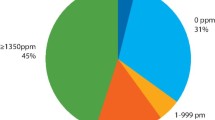Abstract
Data sources Data sources were the Cochrane Oral Health Group Trials Register, Cochrane Central Register of Controlled Trials, Medline and OLDMedline, Embase, LILACS (Latin American and Caribbean Health Sciences Literature), BBO (Brazilian Bibliography of Dentistry), SIGLE (System for Information on Grey Literature in Europe) and Digital Dissertations. Bibliographies of relevant articles were searched and attempts were made to identify unpublished and ongoing studies. Several relevant journals were also searched by hand.
Study selection There was no language restriction. Randomised controlled trials (RCT) or quasi-RCT were selected if they had an intervention or follow-up period of >3 years and compared fluoridated and nonfluoridated milk.
Data extraction and synthesis Inclusion criteria, data extraction and quality assessment were carried out independently and in duplicate, with disagreements being resolved by discussion and agreement being assessed using Kappa. Mean differences and standard deviations were used to summarise data.
Results Out of 144 articles identified by the searches, only two met the inclusion criteria. Since only one report was available as an abstract, unpublished information was requested from the authors and included in this review. A total of 353 children, who had baseline ages of 3–5.5 years, were involved in the studies. The fluoride levels in the two reports differed (2.5 or 7.5 mg/l) and therefore their results could not be combined. After consumption of fluoridated milk for 3 years there was a significant reduction in DMFT (78.4%, P<0.05) between test and control groups in one study. In the other study, although mean DMFT and DMFS were more favourable in the test group, no significant reductions in DMFT were observed until the fourth (35.5%, P<0.02) and fifth years (31.2%, P<0.05). For primary teeth there was a significant reduction in DMFT (31.3%, P<0.05) between the test and control groups after 3 years in one study but not the other. No intent-to-treat analysis could be carried out.
Conclusions The two studies that were of sufficient quality to be included in this review suggested that fluoridated milk was beneficial to schoolchildren by helping prevent caries in the permanent dentition. There remains, however, a dearth of studies providing high-quality evidence of the effects of fluoridated milk.
Similar content being viewed by others
Log in or create a free account to read this content
Gain free access to this article, as well as selected content from this journal and more on nature.com
or
Author information
Authors and Affiliations
Additional information
Address for correspondence: Emma Tavender, Review Group Co-ordinator, Cochrane Oral Health Group, University Dental Hospital of Manchester, Higher Cambridge Street, Manchester M15 6FH, UK. E-mail: emma.tavender@man.ac.uk
Yeung CA, Hitchings JL, Macfarlane TV, Threlfall AG, Tickle M, Glenny AM. Fluoridated milk for preventing dental caries. The Cochrane Database of Systematic Reviews 2005, Issue 3. Art. No. CD003876
Rights and permissions
About this article
Cite this article
Twetman, S. Fluoridated milk may be beneficial to schoolchildren by helping prevent caries. Evid Based Dent 6, 88 (2005). https://doi.org/10.1038/sj.ebd.6400357
Published:
Issue date:
DOI: https://doi.org/10.1038/sj.ebd.6400357



